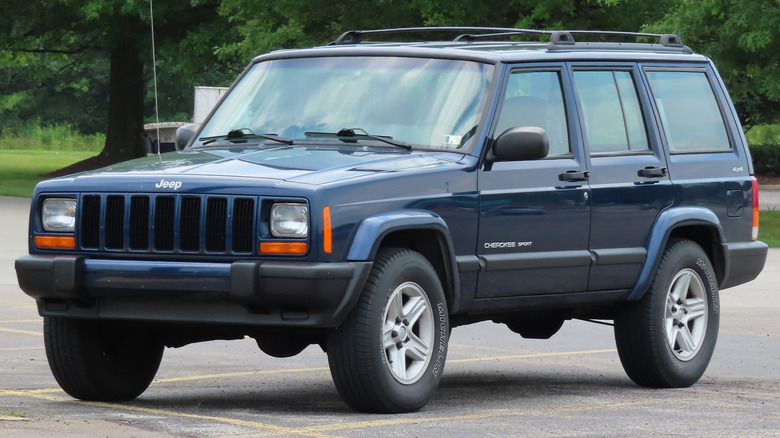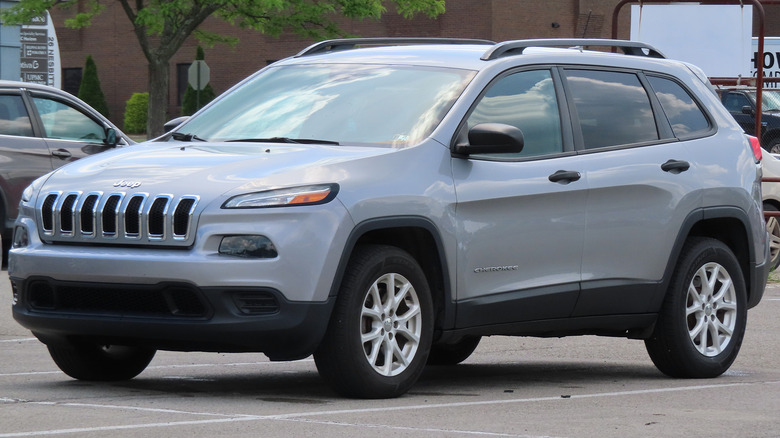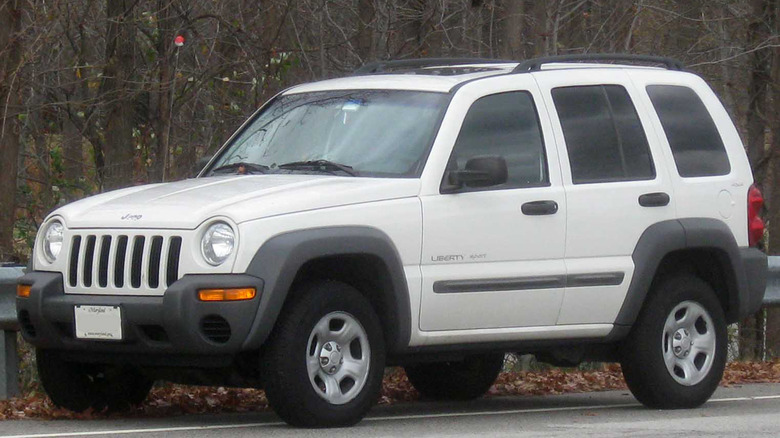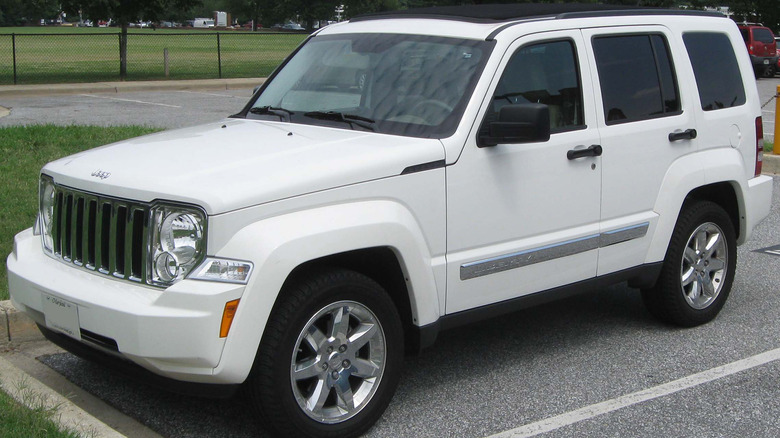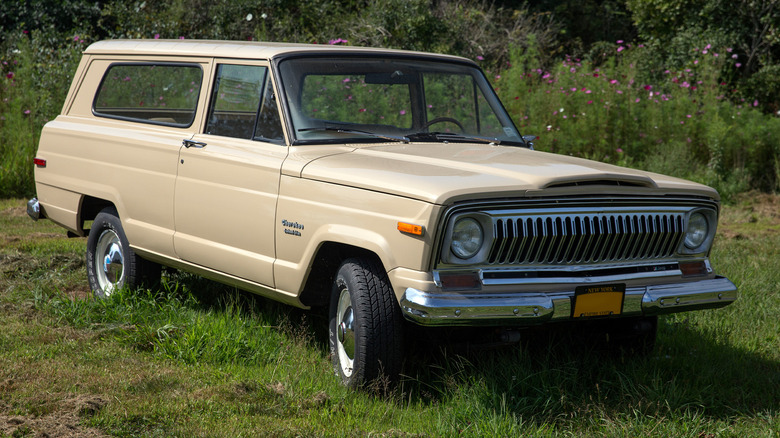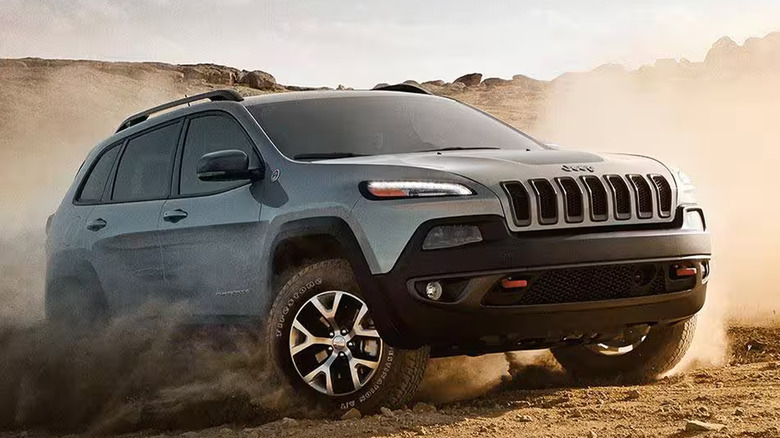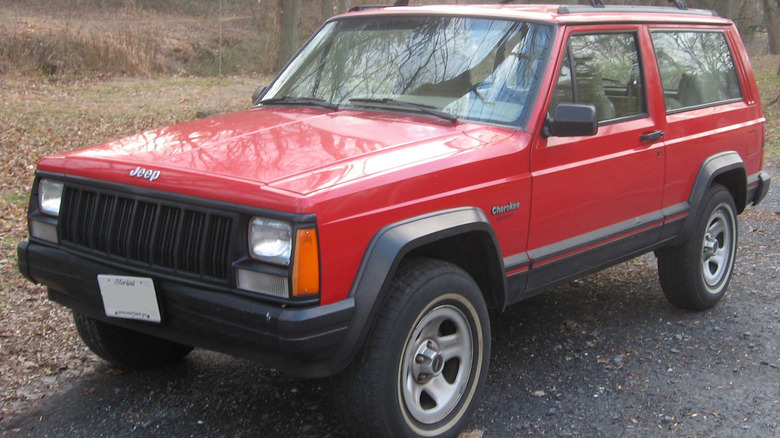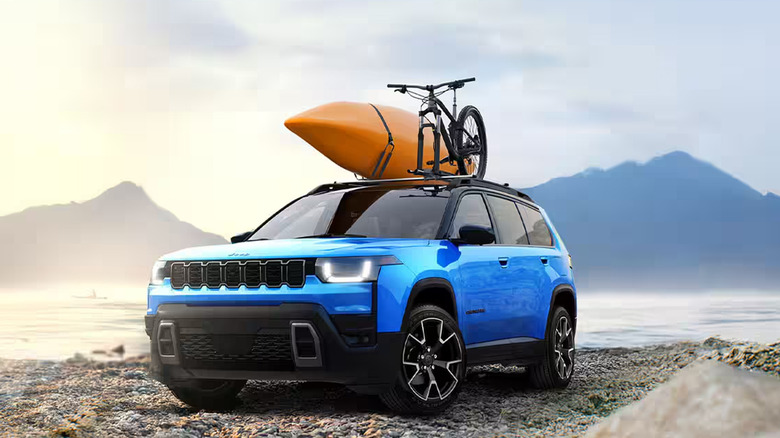Every Generation Of Jeep Cherokee, Ranked
The Jeep Cherokee — not to be confused with the larger Jeep Grand Cherokee — is one of Jeep's most interesting vehicles when it comes to its history. Jeep brought the Cherokee to life in 1974 to fill the space underneath the much larger Jeep Wagoneer at the time. The two shared a lot of design elements, but the basic idea was that the Cherokee was meant to appeal to younger people instead of full-sized families like the Wagoneer. It has bounced in and out of the Jeep lineup until 2023 when Jeep formally retired the badge.
Despite being around for nearly 50 years, the Cherokee actually only has five generations. That number will increase to six since the Cherokee is coming back for the 2026 model year with a fresh coat of paint and a new design that more closely resembles that of the rest of Jeep's SUV lineup. That means on average, a Cherokee generation tends to last around 10 years, with the shortest generations being the third and fourth at around five or six years, respectively. They have been a big deal for Jeep, giving it its firmest grasp in the crossover segment the automaker has ever had.
However, not all generations were built the same. We'll go more into it below, but suffice it to say that some generations were better, more influential, and fit into the market better than others. If you're curious about the best Jeep Cherokee generations, read on.
How We Chose
Before we begin, you may be curious about how we ordered this list. Some of the reasons will be come immediately evident once you browse through and get all of the details. For example, the third-generation Jeep Cherokee wasn't even called the Jeep Cherokee here in the States. It's kind of hard to top a list when there are people out there who don't even know that they owned and drove a Jeep Cherokee to begin with. Again, we'll get more into that as the article goes.
For the rest, it was mostly just a determination of whether or not the Jeep Cherokee generation was good. For example, the first generation was a little weird where it had a two-door and four-door version and it was mostly a clone of the Wagoneer. By contrast, the second generation was staunchly its own product that lasted for nearly two decades. The second generation made more of an impact on the Jeep market than the first generation. Each generation will have its own explanations, but for the most part, we ordered these based on utility, importance, popularity (where we could find the numbers to back it up), and general longevity.
Finally, the sixth generation Cherokee isn't on the market yet, so there aren't a lot of details about it. It may be the best Cherokee that Jeep ever made, or it might be the worst. Time will tell.
5. Third-generation Cherokee
First, there's the runt of the litter, the third-generation Cherokee, or as you might know it, the Jeep Liberty. This generation lasted just a few years from 2002 to 2007. We're not quite sure on every detail, but Jeep decided to shake things up with its naming, calling the vehicle a Liberty in the U.S. while continuing to badge it as the Cherokee elsewhere. Officially, Jeep refers to this one as the Jeep Liberty (KJ). Since a lot of people didn't even know it was a Cherokee, we think the Liberty didn't do much to push the Cherokee forward in terms of consumer sentiment.
With that said, the vehicle was okay. It came with a beefier-than-average four-wheel drive system than most other compact crossovers, which made it superior for off-roading, a character trait that the Cherokee has almost always held. However, it didn't have the handling of its competitors in that era, and the 3.7-liter V6 was a thirsty boy, pulling down 16 MPG in the city and 20 MPG on the highway, which combined for 17.
Otherwise, everything about this generation was fairly mediocre. Some people liked the SUV while others weren't fans. It wasn't super competitive in its segment, except for the four-wheel drive modes that helped it do better off-road. The Jeep Liberty KJ was mostly forgettable, and as a Cherokee, it might as well not be there. Maybe Jeep made a good decision with the name change.
4. Fourth-generation Cherokee
The fourth-generation Cherokee, which is officially named the Jeep Liberty (KK) by Jeep, is much the same as its predecessor. It was still the Cherokee overseas, so it's still a Cherokee everywhere except the United States. This generation lasted from 2008 to 2012, making it the shortest Cherokee generation to date. That works in its favor because the fifth-generation Cherokee returned the nameplate to the U.S., thereby ending the Liberty lineup entirely. In any case, much like the other Jeep Liberty, this generation was decent, but nothing to write home about.
For starters, Jeep removed the four-cylinder engine from the lineup, leaving buyers with the more robust V6 that came in either a diesel or regular gas variety. Much like its predecessor, it had a special four-wheel drive mode for off-road use, putting it at the top of its segment. Sadly, the thirsty V6, mundane on-road performance, and even auto reviewers couldn't find many reasons to recommend it to folks. There was very little to separate it from the prior generation outside of some minor improvements that did make the fourth generation slightly better.
The only reason we're putting this one above the prior generation was that it was so short, so it didn't have much time to make any sort of impact, be it positive or negative. Customer reviews for the car were average, and it has its fair share of haters as. At least it didn't hang around long enough to become a problem. Next!
3. First-generation Cherokee
The first-generation Cherokee is the one that started it all. It is tied for the second-longest generation in Cherokee history, with 10 total model years dating from 1974 to 1983. As was the case back then, automakers were still mostly throwing spaghetti at the wall to see what stuck, especially in the wake of the Clean Air Act that gutted the muscle car era. The Cherokee was an attempt at building a full-size SUV in a smaller form factor while using the company's then-recent acquisition of American Motors (AMC). Plenty of Jeeps were made with AMC engines back then, and the Cherokee was one of them, sporting the AMC 401 V8.
Overall, this generation was just okay. At the time, the Cherokee was just a slightly smaller Wagoneer, so it hadn't yet gained its own identity. It did have some sweet trim names, though, including the Chief, Golden Eagle, Golden Hawk, and Laredo. That last one is a trim level that Jeep still uses today on the Grand Cherokee models. It didn't sell as well as its successors, but it was a decent overall start for the Cherokee.
Even so, the first-generation Cherokee did show Jeep the way and would pave the way for more successes down the line. It's still considered a collector's item among some enthusiasts. That's mostly due to rarity. The 1978 model sold only 41,000 units, showing how unpopular it was. Otherwise, this generation would be further up the list.
2. Fifth-generation Cherokee
The fifth-generation Cherokee was the last one before Jeep discontinued the name for a little while. It ran for 10 years, which ties the first generation in terms of longevity. Jeep made this from 2014 through the 2023 model year, and it is the most recent Cherokee until the 2026 model comes out. It doesn't look much like its predecessors, sporting that hallmark egg shape that crossovers are known for, which helped it blend in more with its competitors. Jeep also made this one for on-road driving with a special trim known as the Trailhawk that excelled at off-road driving.
For Jeep, the fifth-generation Cherokee was a tale of two SUVs. The first included most of the lineup that had modern features like Android Auto and decent all-wheel drive along with plenty of driver amenities. Then you had the Trailhawk, a mid-trim option that substantially amped up off-road capabilities. The on-road versions of the Cherokee were mostly competitive. Fuel economy wasn't great even on the base engine, but it rode nicely, and the extra creature comforts met or exceeded competitors. The Trailhawk, however, was widely considered the best off-road crossover SUV that money could buy.
It was a good generation, overall. It was competitive on-road, unlike the Liberty, and the Trailhawk sat uncontested at the top of the off-road leaderboards. I owned one of these once upon a time, and I still miss it sometimes, although I do regret getting the wildly underpowered four-cylinder engine.
1. Second-generation Cherokee
The Jeep Cherokee's greatest success came in the second generation. It lasted for a long time, running from 1984 to 2001, and it is likely the Cherokee that millennials remember their parents driving. It was undoubtedly the most popular generation in Cherokee history. Its longevity was lent to several factors, including being Jeep's best example of being in the right place at the right time. Jeep downsized the SUV to a crossover size with the second generation, putting a real gap between it and Jeep's larger SUVs. This turned out to be the correct decision in an era where fuel prices were up and engine power was down.
It was Jeep's first unibody SUV, and one of the first unibody crossovers ever. Now that crossovers rule the streets, Jeep deserves credit for being one of the first to get there. It also helps that people loved this thing, often citing it as one of the most influential vehicles ever designed. Jeep refers to it as a legendary vehicle, and enthusiasts seem to agree that it was one heck of a crossover. It was also highly reliable. We were able to find multiple examples of them in the wild with over 300,000 miles.
You get the idea. The second-generation Cherokee was the best, most influential model in the badge's history, and it was on the frontlines when the crossover SUV started taking over America. It doesn't get much better than that.
Wildcard: Sixth-generation Cherokee
Now it's time to talk about the 2026 Cherokee, which will be the first model year of the sixth generation. It hasn't hit the market yet, and not even auto reviewers have tested it as of this writing. While this generation will exist in the very near future, it's difficult to place it on a ranked list. It might be the best thing Jeep has done since the Wrangler or it might be another mundane, forgettable vehicle like the Liberty. We simply won't know until it releases.
However, we'll tell you what we do know. It'll have an all-wheel drive system worthy of off-road prowess, per Jeep. The upcoming Cherokee will also house a turbocharged 1.6-liter inline-four with a hybrid system rated at 38 MPG combined, according to Jeep. The whole package is rated to tow 3,500 pounds. Based on those specs, we can take an educated guess that this will be the most fuel-efficient Cherokee yet, but pales in comparison when it comes to towing capacity. In terms of design, Jeep returned to its roots, giving the upcoming Cherokee design cues from the existing Wagoneer, especially the cabin.
The upcoming Cherokee will lose some utility from prior generations when it comes to stuff like towing, but it will gain back in fuel economy while still keeping some off-road prowess under its chassis. We're not sure how the market'll receive it, but we'll likely find out more later this year.
